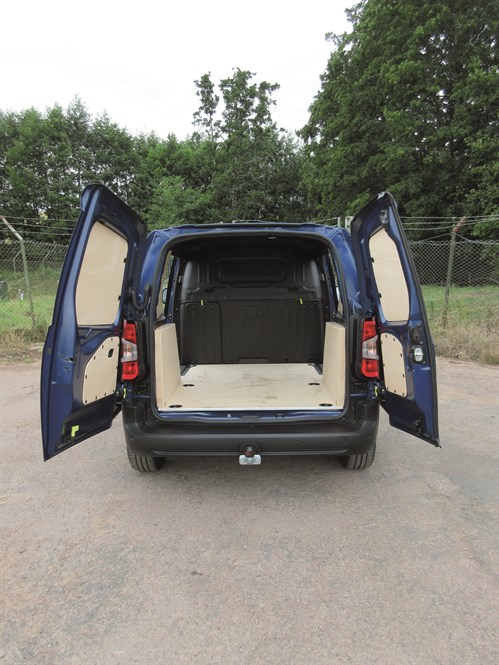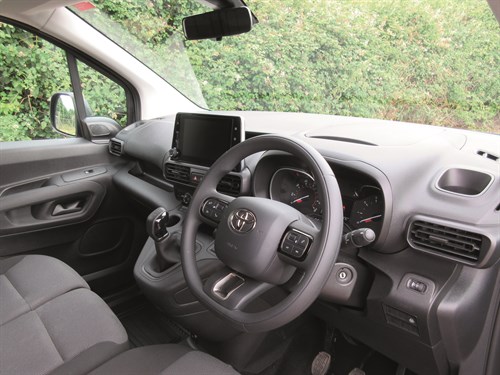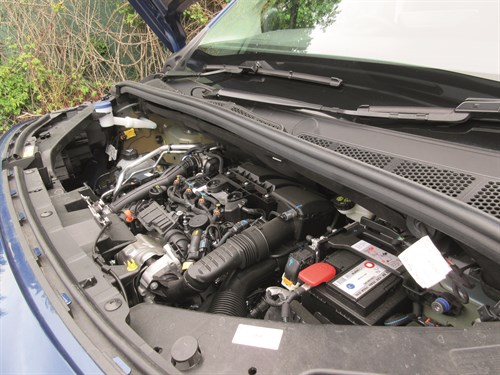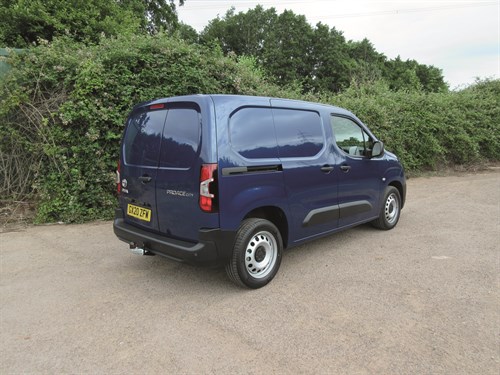Having done little more than dabble half-heartedly in the van market for many years, Toyota has adopted a much more positive stance of late. In doing so it is admittedly relying heavily on another manufacturer’s products, but that by no means makes it unique.
That other manufacturer is PSA.
Toyota’s Proace medium-duty panel van is a rebadged version of Citroen’s Dispatch, Peugeot’s Expert and Vauxhall’s Vivaro. PSA owns all three of these brands, and the models concerned share the same design.
Somewhat confusingly, the new Proace City – the subject of our road test – is not a variant of the Proace. Instead, it is another iteration of PSA’s smaller Citroen Berlingo/Peugeot Partner/Vauxhall Combo.
That means four dealer networks sell what is at heart the same model. That gives prospective customers plenty of opportunity to shop around for the best deal, and play one local dealer off against another.
The quartet of vehicles jointly drove off with the What Van? Light Van of the Year award for 2020.
The bedrock of Toyota’s light commercial line-up is, of course, a product that is very much its own: the legendary Hilux pick-up, which has just been facelifted and given more power. Something else that has the Toyota brand running all the way through it is the Land Cruiser Commercial, a van based on the big 4×4 Land Cruiser SUV.
Returning to the Proace City, it comes as either the Short (2,785mm wheelbase) or the Long (2,975mm wheelbase), with load cubes of 3.3m3 and 3.9m3 respectively. Under the bonnet you will find a 1.5-litre diesel at either 75hp or 100hp, married to a five-speed manual transmission in both cases.
An electric model is scheduled to appear in 2022.
The Short can cope with a 650kg gross payload, rising to 1,000kg if you choose the 100hp option. Marketed solely with the more powerful engine, the Long can handle 950kg.
Two trim levels are listed. Entry-level Active is offered on the Short only, while Icon can be specified on either length.
We decided to get to grips with a 100hp Icon Short.

Load bay
Access to the cargo area is through asymmetric twin rear doors capable of being swung through 180° plus a sliding door on each side of the body – a standard arrangement on all Proace City models.
They all come with a full-height steel bulkhead too. However, Icon bulkheads incorporate a hatch that allows extra-long items to be slid aboard without the need to have them sticking out of the back of the vehicle. It is an arrangement Toyota refers to as Smart Cargo.
Six floor-mounted tie-down points are provided, and our demonstrator’s cargo bay was ply-lined – a sensible precaution that helps prevent minor damage to the load bed and sides when loading and unloading.

Interior and equipment
While Active models come with two seats in the cab, Icons are three-seaters. The outermost passenger seat folds down to make it easier for pipes, planks and so on to be pushed through the aforementioned bulkhead hatch, and transported. Doing so extends the length of the 1,817mm-long cargo floor by a, potentially very useful, 1,273mm.
Three seats in a cab of this size are of limited value given that an adult occupant of the middle seat has no legroom whatsoever. That said, vans with this seating configuration hold their value well on the second-hand market because a couple with a child can use them as personal transport at the weekend.
Furthermore, the back of the middle seat can be folded forwards to create a desk, and rotated towards the driver so that it can be more easily used.
The Proace City comes with a high level of specification. Even Actives get manual air conditioning, while Icon trim adds front and rear parking sensors, a reversing camera, automatic wipers, cruise control with a speed limiter, front fog lights and cornering lights, and an electronic parking brake.
Also installed is a multimedia package with an 8in colour touchscreen plus smartphone integration with Android Auto and Apple CarPlay. Bluetooth and USB connections are provided too, as is DAB audio.
With Active or Icon, for your money you benefit from automatic headlights, electric windows, and heated and power-operated exterior mirrors. Upgrade to Icon and the latter are power-folding too.
Remote audio controls are located on the steering wheel. Both the wheel and the driver’s seat are height-adjustable, and the seat boasts lumbar adjustment.
In-cab storage facilities include a full-width shelf above the windscreen, two pockets in each of the doors, an air-conditioned glovebox, a lidded compartment above the instrument panel, and a shelf behind the upstanding touchscreen. Cupholders are positioned at each end of the dashboard.
All the usual electronic safety systems are present and correct. The line-up includes ABS with electronic brakeforce distribution and brake assist, vehicle stability control, hill-start assist control, and downhill assist control. A tyre pressure monitoring system is installed, as are driver and front passenger airbags.
Our demonstrator came with an optional Toyota Safety Sense package, which includes lane departure alert. It also embraces road sign assist, which highlights the speed limit in force on the road the van is travelling down and helps ensure the driver does not breach it.
Included too is pre-collision system. It intervenes automatically at speeds of up to 18mph to prevent accidents, applying the brakes and bringing the van to a halt if necessary. It reacts at above 18mph too, reducing the vehicle’s speed to mitigate the consequences of an impact if the driver fails to react to looming danger. Also included in the deal is an alarm, which will trigger if somebody smashes any of the cab’s glass or tries to tamper with the vehicle in any way.
Two Safety Sense Packages are on offer – one with a towbar and one without. Our van was equipped with the former.
Disc brakes – ventilated at the front – are fitted all round.
Speed-sensitive electric power steering helps deliver a 11.29m turning circle wall to wall, shrinking to 10.79m kerb to kerb.
Turning to the suspension, MacPherson struts and an anti-roll bar are installed at the front while a torsion beam set-up is deployed at the back. The Icons sit on 16in steel wheels, shod in our case with 205/60 R16 Michelin Energy Saver tyres.
It’s good to see there’s a full-size spare wheel.

Engine
The four-cylinder 16-valve in-line common rail direct-injection diesel engine produces its maximum power output at 3,500rpm. It is equipped with a variable-nozzle turbocharger, which delivers top torque of 250Nm at 1,750rpm.
A diesel particulate filter and AdBlue are required to ensure that the Proace City meets the Euro6 exhaust emission regulations. The AdBlue is held in a 17-litre reservoir.
Driving
With 100hp to call on and next to no weight onboard, the Proace City Short turned out to be a real flyer. It nipped sharply away from rest, accelerated strongly through the gears, and was happy to maintain the maximum legal motorway speed against all-comers.
A smooth gear change aided its progress. The only problem with the gears was that there weren’t enough of them. While a five-speed transmission may be fine if you spend most of your life in city centres or trundling around country lanes, most light commercials have to tackle dual-carriageways and motorways from time to time. It is then that a sixth gear comes in handy, and helps keep fuel consumption in check.
Although the steering initially felt a little over-assisted, Toyota’s newest offering handled well, enabling us to tackle tight bends on rural roads with a fair degree of confidence. It struggled a little on uneven road surfaces when lightly laden however, and in-cab noise levels were a touch too high.
Build quality was exemplary, however, with no creaking or groaning.

Operating
One benefit of opting for the Proace City is its five-year/100,000-mile warranty, including AA roadside assistance for the duration. The paintwork is warranted for three years and the body carries a 12-year anti-perforation corrosion guarantee. The package is significantly more generous than the support that accompanies the PSA-badged alternatives. A service is needed when the relevant warning light comes on.
If the van is not working in an arduous environment and is treated kindly then it may be a long time before the light illuminates. As a consequence, Toyota asks operators to ensure that the Proace City visits a workshop every two years/25,000 miles, whichever comes first.
Toyota quotes WLTP (Worldwide Harmonised Light Vehicle Test Procedure) fuel consumption figures of 46.3mpg-50.4mpg along with a 151g/km WLTP CO2 figure. We were averaging around 50mpg on a mixture of rural, motorway and urban routes, lightly laden.
A stop/start system, standard on both Actives and Icons, helps keep diesel usage and emissions down. Side rubbing strips help protect the body from minor damage.
While the Proace City is undoubtedly specification-rich, there are some notable omissions from the vehicle line-up. A 130hp version of the 1.5-litre diesel, a six-speed manual gearbox, an eight-speed auto gearbox and a 4×4 variant all form part of the PSA portfolio, but Toyota is not taking any of them. Nor is it listing the optional overload indicator, or marketing what it has to offer as a crew van.
We’re not expecting it to list all of them – but adding the six-speed box as an option would be a good start.
Toyota Proace City Icon Short 100hp
Price (ex VAT) £20,090
Price range (ex VAT) £17,465-£20,715
Gross payload 1,000kg
Load volume 3.3m3
Load length 1,817mm
Load width (min/max) 1,229/1,527mm
Load bay height 1,200mm
Loading height 548mm
Rear door aperture 1,241×1,196mm
Side door aperture 675×1,072mm
Gross vehicle weight 2,365kg
Braked trailer towing weight 1,500kg
Residual value 23.3% (after 4rys/80,000mls. Source – KwikCarcost)
Cost per mile 40.4p
Engine size/power 1499cc, 100hp @ 3,500rpm
Torque 250Nm @ 1,750rpm
Gearbox 5-spd
Fuel economy (Combined WLTP) 46.3-50.4mpg
Fuel tank 50 litres
CO2 151g/km
Warranty 5yrs/100,000mls
Service intervals 2yrs/25,000mls
Insurance group 34E
Price as tested £21,348
Options
Metallic paint £454
Toyota Safety Sense including tow bar £804
Rivals
Ford Transit Connect
Price (ex VAT) £16,575-£22,765
Load volume 2.9-3.6m3
Gross payload 579-876kg
Engines 100hp 1.0 petrol, 75hp, 100hp, 120hp 1.5 diesel
Verdict: With a slick gear-change and top-notch handling and performance, the Connect underlines the truth of the old maxim that nobody ever got shot for buying a Transit. It’s fuel-frugal and the cab interior is comfortable and well laid out, with ample storage. It all helps to explain why Ford remains the UK market-leader by a wide margin. The diesel is the same 1.5 in the Proace City.
Renault Kangoo/Kangoo Maxi
Price (ex VAT) £16,650-£33,120
Load volume 3.0-4.0m3
Gross payload 605-800kg
Engines 80hp, 95hp, 115hp 1.5 diesel, 44kW electric
Verdict: A new Kangoo is set to arrive either late this year or early next year, but that does not mean the virtues of the existing offering should be ignored. Its diesels are fuel-efficient, its gearboxes user-friendly, and the electric Kangoo Z.E.’s range between battery recharges got a bit of a boost a while back. No news as yet as to whether the UK will get the fuel cell Kangoo though.
VW Caddy/Caddy Maxi
Price (ex VAT) £16,055-£26,015
Load volume 3.2-4.2m3
Gross payload 634 -738kg
Engines 102hp 1.0 petrol, 102hp, 150hp 2.0 diesel
Verdict: If you want a compact van with rock-solid build quality that looks as though it will last forever, then your search is over. The Caddy has other virtues too. While they do not include innovative styling, they certainly embrace exemplary diesel engines and top-notch on-the-road performance and handling. A new Caddy has been unveiled and should be in dealerships during Q1 of 2021.
The Final Verdict
Design 7/10 – Fine, but a pity Toyota hasn’t taken all of the options PSA has in its grab bag.
Cabin 7/10 – Equipped to a high standard, but middle seat lacks leg and shoulder room.
Ride 6/10 – Struggles a little on uneven highway surfaces when lightly laden.
Refinement 7/10 – No squeaking/creaking, but more attention needs to be paid to in-cab noise.
Load area 8/10 – Easy to access. Load-through facility makes it easier to take longer items.
Handling/performance 8/10 – Neither give cause for concern. Enough power to meet most situations.
Engine/transmission 6/10 – Nothing wrong with the former, but the latter could do with an extra gear.
Standard equipment 9/10 – Plenty of goodies, with even entry-level models fitted with air conditioning.
Operating costs 9/10 – Long warranty is to be praised. Residuals should be healthy.
What Van? subjective rating 8/10 – An attractive package and a worthy addition to the Toyota LCV line-up.
Overall Rating = 75/100





